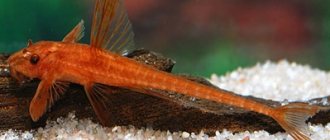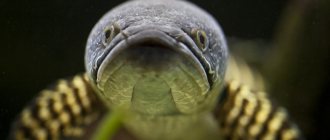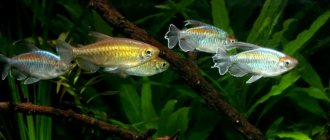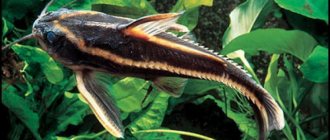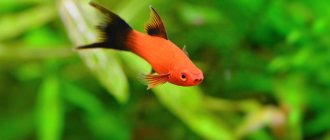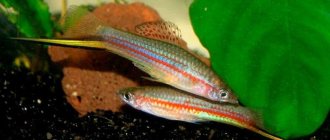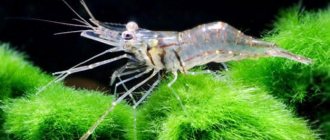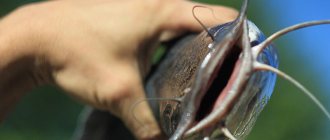Scarlet barbs are bright and unpredictable fish, real live creatures that fly across the expanses of the aquarium and kindly bully everyone. This variety is less popular than its relatives as it is rarely available for sale. The fish are unpretentious and quite peaceful, perfect for keeping in a community aquarium. Even a novice aquarist can take care of them.
Beautiful active fish with a kind, playful character
Description
Scarlet Barbus (Puntius) is a representative of the Carp family of the Barbus genus. It also has other names - scarlet Odessa barb or tikto barb. The natural habitat of the species is the Republic of Myanmar, India, Thailand, the Himalayas, their surrounding creeks, lakes and small rivers. Although the puntius is not considered a bottom fish, it still spends a significant part of its time digging the muddy bottom in search of food.
Appearance
The body is elongated and laterally flattened. The head is triangular and pointed towards the end. The scales are large and clearly visible, the scales are painted silver. The belly of the fish is painted in light beige tones, the back is green-gray, and the color of the sides is gray-metallic. On the sides there are two black spots on each side - near the gills and at the caudal fin. A distinctive feature is a red-scarlet stripe running from head to tail. The fins have pronounced black elongated spots.
The size of the fish is small, in natural conditions 6–8 cm, but with involuntary breeding, representatives grow much smaller—3–5 cm.
Behavior
In aquariums it lives in the upper or middle layers of water. The character is peaceful and does not show much aggression towards other inhabitants. It leads a very active and mobile lifestyle, so it needs a large aquarium.
The Odessa barb is a schooling fish, so keeping them alone leads to poor health and illness of the fish. In nature, they live in schools of several dozen to hundreds of fish. Add at least 5-6 scarlet barb fish to the aquarium.
Scarlet barbs in their natural environment
The homeland of representatives of this species is Southeast Asia, where they are found over a fairly vast territory - from the Himalayan to Thai reservoirs. You can also find scarlet barbs in Bangladesh, China, India, Laos, Burma, Nepal, and Pakistan.
Very often, fish choose a backwater or dam of a large or medium-sized river as their habitat. Typically, these reservoirs have a muddy bottom, where barbs hunt for food.
Content
Red barbs are easy to care for and do not have any specific maintenance features. The main thing in keeping scarlet barbs is to keep them not alone, but in a flock. In other cases, fish are not too sensitive to the mistakes of aquarists.
Scarlet barbs prefer clean water with a weak current that resembles natural water. Every week some of the water is replaced with new water. To ensure your pets feel normal, do not change the water temperature sharply and avoid drafts.
Aquarium
It is not necessary to choose a large aquarium, because puntiuses feel calm even in limited space. What is more important is not the volume of the aquarium, but its length. It is worth choosing an aquarium with a length of at least 50 cm and a volume of about 80 liters for the flock.
Water parameters
Water temperature is 20–25 degrees. The hardness level is 10–15 dGH, and the acidity level is 6.5–7.0 pH.
Plants
Any vegetation is suitable for the aquarium, but remember that aquarium fish, the scarlet barb, dig through the bottom. For plants with weak root systems, the roots will suffer. The best option would be to choose artificial plants, floating plants or plants with strong root systems.
Plants for an aquarium with scarlet puntius:
- Azolla carolina or water fern.
- Humboldt's marsh flower.
- Salvinia floating.
- Small duckweed.
- Pistia or water lettuce.
- Riccia floating.
Priming
For an aquarium with Odessa puntius, medium-sized or large-sized soil with no cracks or sharp parts that could injure the puntius is suitable. Coarse sand, large pebbles or a special soil mixture substrate are suitable.
Equipment
The aquarium is equipped with an aeration device and a filter. The aerator is necessary to enrich the water with oxygen, which the fish need, and the filter will keep the water clean.
How to breed scarlet barbs
Considering the unpretentiousness of scarlet barbs and the ease of their breeding, the fact of their low prevalence becomes surprising. Representatives of the species spawn, but do not bother themselves with caring for the fry. One litter consists of one and a half hundred eggs, from which fry hatch within a day. And after 3 days, newborns begin to eat and swim independently.
To obtain offspring of scarlet barbs, it is necessary to prepare a separate small tank and place plants with small leaves on its bottom. Experts recommend covering the surface with a protective net - this will prevent parents from eating the eggs.
A little settled water is taken into the spawning tank - 15-20 cm thick, it can also be taken from a common reservoir. The only peculiarity is that the temperature should be 24°-25°C. Aeration of the water is necessary, but it should not be too intense and not disturb the future parents. It is important to remove the tank from direct sunlight - scarlet barb eggs do not tolerate them well.
The fish begin to spawn early in the morning. This can be noticed by the behavior of the male - he begins to rush after the female, demonstrating his bright coloring. The female lays eggs on any objects - from vegetation to stones, while the male is engaged in fertilization.
To prevent the couple from feasting on caviar, it is advisable to immediately return them to the common tank. It is advisable to place the container in a dark place or cover it with a sheet of paper. In a day, larvae will appear from it, and after 3 days - fry.
Scarlet barbs are cute fish that lead an active lifestyle, adhering to a hierarchical system. You can admire them and also observe their vigorous activity.
Feeding
Under natural conditions, the Odessa barb feeds on insects and their larvae in the silt. When kept in an aquarium, it is unpretentious to food and eats everything. Any type of food is suitable for Puntius: frozen, dried or live. But a certain percentage of the diet consists of plant foods. If you feed your fish only protein foods, this will lead to diseases.
Fish have a good appetite, which often leads to overeating. Barbs are able to swim and eat all day long, but it is better to know the measures in feeding the fish and feed the fish 2 times a day.
View this post on Instagram
Posted by Pascal Wolterman (@pascalwolterman) Nov 8, 2021 at 10:53 am PST
How and what to feed scarlet barbs
In nature, these fish eat insects, larvae, plants and detritus. With such omnivory, it is not difficult to create a diet for the inhabitants; they will eat whatever the owner offers them - live, frozen food, artificial granules or flakes. But it is important that the menu of scarlet barbs be varied. When feeding the inhabitants of the aquarium, you can adhere to a number of rules:
- they should be given a portion of food that the fish can eat within 5-7 minutes;
- food residues must be immediately removed from the tank - particles remaining in the water begin to decompose, rot, polluting it;
- once a week you should give your barbs a fasting day;
- underfeeding is less harmful to these inhabitants than overfeeding;
- the selection of dry food should be approached with caution; such food can cause bloating and other problems in fish;
- When feeding barbs, it is recommended to use special feeders - floating on the surface and preventing particles from spreading over the entire surface.
In general, barbs are unpretentious and do not require any special nutrition.
Compatibility
When choosing neighbors for your puntius, it is worth remembering that barbs are school animals. The absence of a pack will cause stress and illness in your pet. Good compatibility with other varieties of barbs, for example, cherry or Sumatran barbs. Compatible with peace-loving fish: congo, tetra, zebrafish, mollies.
Puntiuses cannot stand proximity to predatory fish, for example, clarius or swordmouth.
And also you should not introduce fish with long and decorative fins. Their barbs love to tear and bite.
Breeding forms
Thanks to the work of selection, it was possible to obtain completely new species of barbs that amaze with their color and appearance.
Dark green uniform
Dark green is one of the most popular forms nowadays. These include:
Barbus mossy
Mutant
Green Tiger
The fish have a slightly elongated body and a dark green tint. The fins are black with red edging. The third subspecies has a golden tint and a light belly.
Albinos
This includes:
Albino
Gold
Barbus strawberry
The first two species can be creamy to golden in color, with white stripes across the body. Strawberries have a bright pink color. All albinos have transparent fins with pink edging and a red head color. Despite selection interference, the albino has not lost its stamina and is suitable for beginner aquarists.
Platinum
Includes three types of barbs:
Platinum
Green platinum
Platinum
They are distinguished by the absence of stripes and the white-blue tint of their scales. They have black fins.
Veiled
They are distinguished by elongated fins, which, when moving, resemble a veil. Otherwise, they do not differ from ordinary Sumatrans, neither in appearance nor in living conditions.
Glofish
Artificially produced form:
Sumatran red barb
Green
Black marble
These are genetically modified fish, in whose DPR the gene of Pacific jellyfish capable of fluorescence has been introduced. Despite the fact that the breeding and sale of these fish is prohibited in many countries around the world, they are gaining immense popularity. The special property is inherited by the fry and becomes more intense with age. The main feature of a fluorescent barb is that it does not glow in the dark. To do this, they need ultraviolet or blue lighting lamps. Otherwise, these fish are no different from their counterparts, either in size or life expectancy. The only difficulty in breeding them is determining their sex, since it is almost impossible to distinguish a male from a female in glofish.
Reproduction
In reproduction, scarlet puntius is characterized by simplicity and the absence of special conditions. For successful breeding, you will need a spawning tank - a small container in which a pair of fish will live until spawning. It is preferable to plant some plants at the bottom and put a net. The mesh is useful for protecting the eggs - the parents are able to eat the eggs, and this way they will fall through the cells and remain safe. The water level is not higher than 17 cm.
Remember that barb eggs are sensitive to light, so choose low lighting.
Diseases
Sumatran barbs are unpretentious fish that, with proper care, will delight their owners for a long time with their bright colors and playful behavior. But careless handling by owners, vitamin deficiencies or infections can cause various diseases.
White-skinned
This is one of the common pathologies that occurs in this species of fish. Among its symptoms, in addition to lethargy and decreased appetite, can be identified a change in the color of the dorsal fin and skin near the tail to white, lightening or complete disappearance of the stripes. A sick barb stays near the surface almost all the time, and the dorsal fin sticks out.
The cause of white skin is bacteria that enter the aquarium with new inhabitants (plants or fish). To cope with the scourge, you need to:
- Dilute oxacillin (40 mg per 1 l) in a prepared container.
- Keep infected individuals in the prepared solution for 5 days.
- Wash and disinfect the main aquarium.
- Rinse the fish of the drug and return them to the restarted main aquarium.
Aeromonosis
Aeromonosis or rubella is an infectious disease that barbs can become infected with from infected fish or through dirty equipment. The infection enters the body through the gills or wounds on the body, and the incubation period is 3-8 days.
Symptoms of the disease against the background of general lethargy and loss of appetite are the appearance of ulcers and red spots on the body, rotting of the anal fin. Unfortunately, with such manifestations it is no longer possible to save the fish, and apparently healthy individuals are treated as follows:
- For seven days, a solution of bicilin-5 is poured into the aquarium at night.
- Infected barbs are kept in baths with antibiotics (chloramphenicol, synthomycin) and methylene blue for 6 hours.
Aquarium fish that have recovered from rubella acquire strong immunity to the disease, but can cause infection to other inhabitants.
Dropsy
Dropsy is an accumulation of edematous fluid in a body cavity. The cause of the disease is most often a bacterial infection, parasites, poor water quality in the aquarium and its sudden changes, and lack of oxygen.
In a sick individual, the scales protrude, the gill covers come off, the abdomen and sides swell, the anus protrudes, and stripes become discolored due to swelling of the skin. Symptoms may not all appear at the same time.
It is impossible to save a sick fish in the later stages, but at the very beginning of the disease you can try to improve its condition by placing it in a chloromycetin solution (80 ml/10 l) for 30 minutes.
Fin rot
This is the most common disease in aquarium fish. Its causative agents are the bacteria Pseudomonas fluorescens, which can enter the aquarium along with food, decor, soil, or new fish that have not been quarantined.
Sick barbs change their color and fins break off, their eyes become cloudy, red spots appear throughout the body due to blockage of blood vessels, and in the final stage, ulcers appear throughout the body.
To save the inhabitants of the aquarium, it is necessary to replace 30% of the water with fresh water, clean the aquarium with all its contents (soil, decor, plants). Sick barbs should be placed in a separate tank, followed by antibiotic therapy.
Obesity
Barbs are quite voracious, so if you overfeed them, you can provoke the development of obesity, which can subsequently result in the death of the pet.
The first signs of obesity are low activity and apathy, an increase in body size compared to the norm. To correct the situation, it is enough to leave the fish without food for two or three days, and then establish a normal diet.
Reviews
The scarlet barb has established itself among aquarists as an unpretentious pet that is relatively easy to breed and raise. Aquarists note that the scarlet puntius brings excitement to any aquarium due to its mobility and curiosity.
Diseases
Like other members of the genus, the ruby barb has excellent immunity and is practically not susceptible to disease. However, under poor housing conditions, fish can be affected by bacterial infections, such as ichthyophthyriasis.
When buying fish at a pet store, you need to carefully examine each selected individual. Those who do not have a rich color behave sluggishly - it is better not to buy .
To avoid introducing hidden infections, new specimens must undergo quarantine.
The scarlet barb is a cheerful and active fish whose life is very entertaining to watch. Their small size and modest requirements for maintenance and feeding allow us to recommend them even to novice aquarists.
Adviсe
- When buying fish, look at its external condition and mobility. Barbs are tireless swimmers, so if the fish in the store is sluggish and inactive, then it is most likely sick. But puntius rarely get sick because they have good immunity.
- When choosing fish, pay attention to the scales. It looks like a pronounced grid and gaps in it indicate health problems.
- The beauty of fish is especially evident in a container with dark soil and diffused light from vegetation floating near the surface.
- Do not overload the aquarium with decorations; it is better to leave more space for swimming.
Who do scarlet barbs get along with?
Representatives of this species are completely peaceful and non-conflict creatures. A flock of scarlet barbs gets along well, and looks good, with other barbs. In addition, they can be housed with the following fish:
- brachydaniorerio;
- Malabar danios;
- Congo;
- diamond tetras and other characins.
Scarlet barbs do not pay attention to shrimp. But it is not recommended to place large and predatory inhabitants with them. Sacbranch catfish, clarius, and swordmouth will consider barbs exclusively as food.
Photo gallery
Appearance
Barbs are agile fish with a body length of up to 8 cm (the natural “ceiling” of their size is 15 cm). The lifestyle is gregarious. In aquarium conditions they live for about five to six years.
The body is oval, elongated, laterally compressed. Thanks to their forked tail fin, barbs are active and fast swimmers.
The coloring is very attractive. The silvery sheen of the dorsal scales is offset by a greenish tint. A special feature that distinguishes fire barbs is a dark round spot with a golden rim, located in the anterior section of the tail. In males, the lateral and ventral scales, as well as the fins, have a scarlet color, which gives such a juicy name to the whole species. The outfit of females is more modest: the scales are gray, brown or bronze tones, the fins are completely colorless.
Veiled varieties of fire barb look even more impressive thanks to the wavy shape of their elongated fins.

